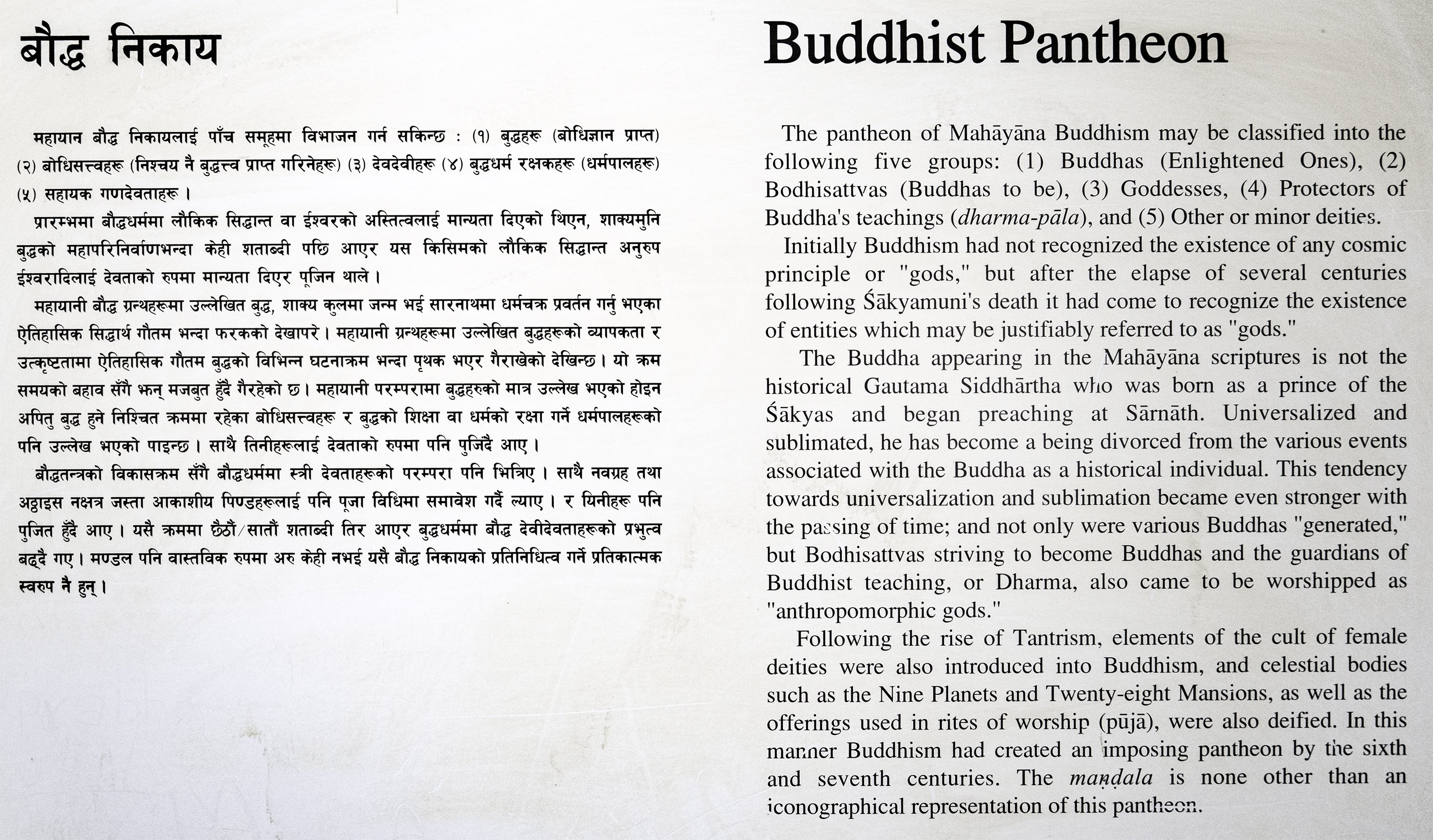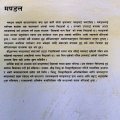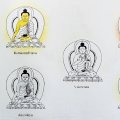Buddhist Art Gallery: Northern Himalayan Section: photo 106
Photo 106 of 198 in Gallery: Buddhist Art Gallery: Northern Himalayan Section

Image title: Buddhist Pantheon (Mahayana)
Description of the photo
English text:
The pantheon of Mahayana Buddhism may be classified into the following five groups: (1) Buddhas (Enlightened Ones), (2) Bodhisattvas (Buddhas to be), (3) Goddesses, (4) Protectors of Buddha's teachings (dharma-pala), and (5) Other or minor deities.
Initially Buddhism had not recognized the existence of any cosmic principle or "gods," but after the elapse of several centuries following Shakyamuni's death it had come to recognize the existence of entities which may be justifiably referred to as "gods."
The Buddha appearing in the Mahayana scriptures is not the historical Gautama Siddhartha who was bom as a prince of the Sakyas and began preaching at Sāmāth. Universalized and sublimated, he has become a being divorced from the various events associated with the Buddha as a historical individual. This tendency towards universalization and sublimation became even stronger with the passing of time; and not only were various Buddhas "generated," but Bodhisattvas striving to become Buddhas and the guardians of Buddhist teaching, or Dharma, also came to be worshipped as "anthropomorphic gods."
Following the rise of Tantrism, elements of the cult of female deities were also introduced into Buddhism, and celestial bodies such as the Nine Planets and Twenty-eight Mansions, as well as the offerings used in rites of worship (puja), were also deified. In this manner Buddhism had created an imposing pantheon by the sixth and seventh centuries. The mandala is none other than an iconographical representation of this pantheon.
Nepalese text (not proofread)
बौद्ध निकाय—महायान बौद्ध निकायलाई पाँच समूहमा विभाजन गर्न सकिन्छ : (१) बुद्धहरू (बोधिज्ञान प्राप्त) (२) बोधिसत्त्वहरू (निश्चय नै बुद्धत्त्व प्राप्त गरिनेहरू) (३) देवदेवीहरू (४) बुद्धधर्म रक्षकहरू (धर्मपालहरू) (५) सहायक गणदेवताहरू ।
प्रारम्भमा बौद्धधर्ममा लौकिक सिद्धान्त वा ईश्वरको अस्तित्वलाई मान्यता दिएको थिएन, शाक्यमुनि बुद्धको महापरिनिर्वाणभन्दा केही शताब्दी पछि आएर यस किसिमको लौकिक सिद्धान्त अनुरुप ईश्वरादिलाई देवताको रुपमा मान्यता दिएर पूजिन थाले ।
महायानी बौद्ध ग्रन्थहरूमा उल्लेखित बुद्ध, शाक्य कुलमा जन्म भई सारनाथमा धर्मचक्र प्रवर्तन गर्नु भएका ऐतिहासिक सिद्धार्थ गौतम भन्दा फरकको देखापरे । महायानी ग्रन्थहरूमा उल्लेखित बुद्धहरूको व्यापकता र उत्कृष्टतामा ऐतिहासिक गौतम बुद्धको विभिन्न घटनाक्रम भन्दा पृथक भएर गैराखेको देखिन्छ । यो क्रम समयको बहावसँगै झन् मजबुत हुँदै गैरहेको छ । महायानी परम्परामा बुद्धहरुको मात्र उल्लेख भएको होइन अपितु बुद्ध हुने निश्चित क्रममा रहेका बोधिसत्त्वहरू र बुद्धको शिक्षा वा धर्मको रक्षा गर्ने धर्मपालहरूको पनि उल्लेख भएको पाइन्छ । साथै तिनीहरूलाई देवताको रुपमा पनि पुजिँदै आए ।
बौद्धतन्त्रको विकासक्रम सँगै बौद्धधर्ममा स्त्री देवताहरूको परम्परा पनि भित्रिए । साथै नवग्रह तथा अठ्ठाइस नक्षत्र जस्ता आकाशीय पिण्डहरूलाई पनि पूजा विधिमा समावेश गर्दै ल्याए । र यिनीहरू पनि पुजित हुँदै आए । यसै क्रममा छैठौं / सातौं शताब्दी तिर आएर बुद्धधर्ममा बौद्ध देवीदेवताहरूको प्रभुत्व बढ्दै गए । मण्डल पनि वास्तविक रुपमा अरु केही नभई यसै बौद्ध निकायको प्रतिनिधित्व गर्ने प्रतिकात्मक स्वरुप नै हुन् ।
Nepalese to English (automated translation)
Buddhist Entities—The Mahayana Buddhist Entities can be divided into five groups: (1) Buddhas (Enlightened) (2) Bodhisattvas (certainly attaining Enlightenment) (3) Devas (4) Buddha Dharma Protectors (Dharmapalas) (5) Assistant Ganadevatas.
In the beginning Buddhism did not recognize the existence of the cosmic principle or the existence of God, Shakyamuni came a few centuries after Buddha's Mahaparinirvana and started worshiping God according to this kind of cosmic principle.
The Buddha mentioned in the Mahayana Buddhist texts appeared differently from the historical Siddhartha Gautama, who was born in the Shakya clan and practiced Dharmachakra at Sarnath. In the comprehensiveness and excellence of the Buddhas mentioned in the Mahayani texts, it seems that they are not separated from the various events of the historical Gautama Buddha. This sequence is getting stronger with the passage of time. In the Mahayani tradition, not only Buddhas are mentioned, but Bodhisattvas who are in a certain order to become Buddhas and Dharmapalas who protect Buddha's teachings or Dharma are also mentioned. They were also worshiped as gods.
Along with the development of Buddhism, the tradition of female deities also entered into Buddhism. Also, celestial bodies like Navagraha and Atthaisa Nakshatra were also included in the worship method. And these too came to be worshipped. At the same time, around the sixth/seventh century, the dominance of Buddhist gods and goddesses increased in Buddhism. The mandala is actually nothing else but a symbolic representation of this Buddhist body.
Transcription (with diacritics):
Bauddha nikāya—mahāyāna bauddha nikāyalāī pāṃca samūhamā vibhājana garna sakincha : (१) buddhaharū (bodhijñāna prāpta) (२) bodhisattvaharū (niścaya nai buddhattva prāpta garineharū) (३) devadevīharū (४) buddhadharma rakṣakaharū (dharmapālaharū) (५) sahāyaka gaṇadevatāharū .
prārambhamā bauddhadharmamā laukika siddhānta vā īśvarako astitvalāī mānyatā dieko thiena, śākyamuni buddhako mahāparinirvāṇabhandā kehī śatābdī pachi āera yasa kisimako laukika siddhānta anurupa īśvarādilāī devatāko rupamā mānyatā diera pūjina thāle .
mahāyānī bauddha granthaharūmā ullekhita buddha, śākya kulamā janma bhaī sāranāthamā dharmacakra pravartana garnu bhaekā aitihāsika siddhārtha gautama bhandā pharakako dekhāpare . Mahāyānī granthaharūmā ullekhita buddhaharūko vyāpakatā ra utkṛṣṭatāmā aitihāsika gautama buddhako vibhinna ghaṭanākrama bhandā pṛthaka bhaera gairākheko dekhincha . Yo krama samayako bahāvasaṃgai jhan majabuta huṃdai gairaheko cha . Mahāyānī paramparāmā buddhaharuko mātra ullekha bhaeko hoina apitu buddha hune niścita kramamā rahekā bodhisattvaharū ra buddhako śikṣā vā dharmako rakṣā garne dharmapālaharūko pani ullekha bhaeko pāincha . Sāthai tinīharūlāī devatāko rupamā pani pujiṃdai āe .
bauddhatantrako vikāsakrama saṃgai bauddhadharmamā strī devatāharūko paramparā pani bhitrie . Sāthai navagraha tathā aṭhṭhāisa nakṣatra jastā ākāśīya piṇḍaharūlāī pani pūjā vidhimā samāveśa gardai lyāe . Ra yinīharū pani pujita huṃdai āe . Yasai kramamā chaiṭhauṃ / sātauṃ śatābdī tira āera buddhadharmamā bauddha devīdevatāharūko prabhutva baḍhdai gae . Maṇḍala pani vāstavika rupamā aru kehī nabhaī yasai bauddha nikāyako pratinidhitva garne pratikātmaka svarupa nai hun .
Transcription (without diacritics):
bauddha nikaya—mahayana bauddha nikayalai pamca samuhama vibhajana garna sakincha : (१) buddhaharu (bodhijnana prapta) (२) bodhisattvaharu (nishcaya nai buddhattva prapta garineharu) (३) devadeviharu (४) buddhadharma rakshakaharu (dharmapalaharu) (५) sahayaka ganadevataharu .
prarambhama bauddhadharmama laukika siddhanta va ishvarako astitvalai manyata dieko thiena, shakyamuni buddhako mahaparinirvanabhanda kehi shatabdi pachi aera yasa kisimako laukika siddhanta anurupa ishvaradilai devatako rupama manyata diera pujina thale .
mahayani bauddha granthaharuma ullekhita buddha, shakya kulama janma bhai saranathama dharmacakra pravartana garnu bhaeka aitihasika siddhartha gautama bhanda pharakako dekhapare . mahayani granthaharuma ullekhita buddhaharuko vyapakata ra utkrishtatama aitihasika gautama buddhako vibhinna ghatanakrama bhanda prithaka bhaera gairakheko dekhincha . yo krama samayako bahavasamgai jhan majabuta humdai gairaheko cha . mahayani paramparama buddhaharuko matra ullekha bhaeko hoina apitu buddha hune nishcita kramama raheka bodhisattvaharu ra buddhako shiksha va dharmako raksha garne dharmapalaharuko pani ullekha bhaeko paincha . sathai tiniharulai devatako rupama pani pujimdai ae .
bauddhatantrako vikasakrama samgai bauddhadharmama stri devataharuko parampara pani bhitrie . sathai navagraha tatha aththaisa nakshatra jasta akashiya pindaharulai pani puja vidhima samavesha gardai lyae . ra yiniharu pani pujita humdai ae . yasai kramama chaithaum / sataum shatabdi tira aera buddhadharmama bauddha devidevataharuko prabhutva badhdai gae . mandala pani vastavika rupama aru kehi nabhai yasai bauddha nikayako pratinidhitva garne pratikatmaka svarupa nai hun .
Gallery information:
The Northern Himalayan region in Nepal offers a wide variety of Buddhist objects such as paintings, scriptures, sculptures, ritualistic objects, etc. Buddhism once entered Tibet from Nepal and has blended in its own way there, resulting in Tibetan Buddhism which is divided into many schools. The items found here are exhibited in the National Museum of Nepal (Rashtriya Museum).
Photo details:
Date: 2019-12-04
Camera: SONY ILCE-6400
Exposure: 1/160
Aperture: f/4
ISO: 400
Focal length: 18mm
High resolution:
Download file
Size: 4.48 MB
Resolution: 3410 x 2000
© Photograph by Gabe Hiemstra.
License: CC BY-NC-ND 4.0

